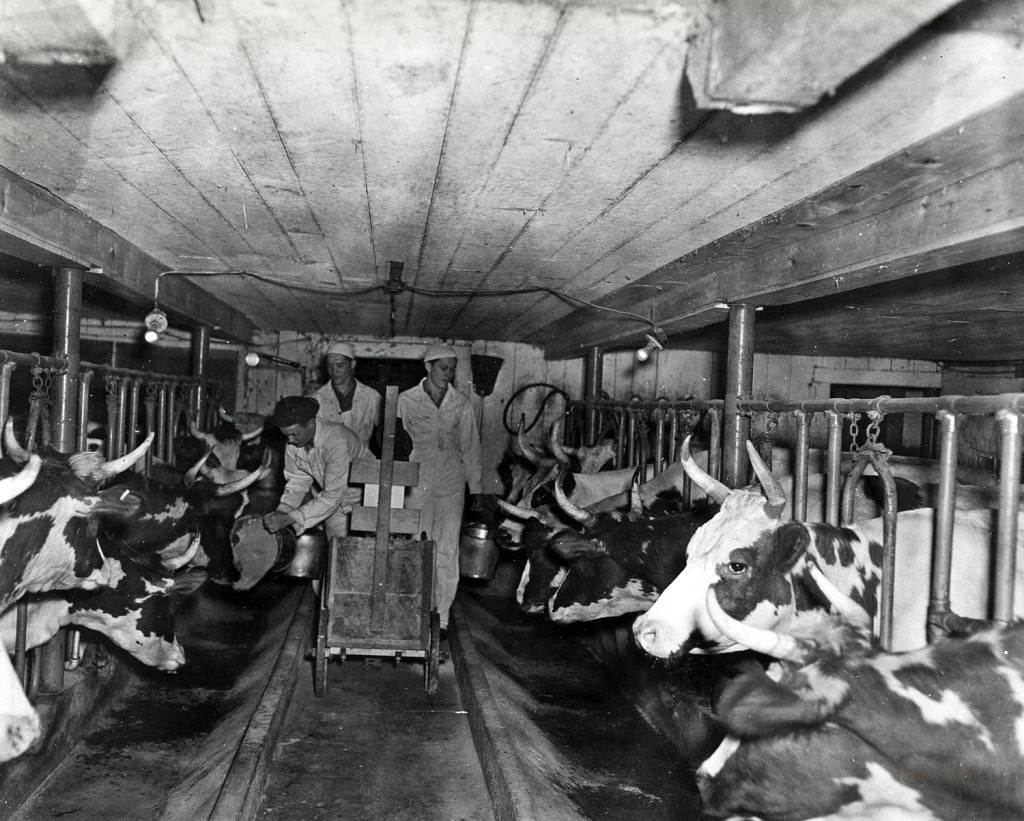Pine Mountain Settlement School
Series 11: FARM
The Dairy at PMSS
c. 1914-1949

Barn interior, feeding the Ayrshire herd at milking time. Arthur W. Dodd Album. [dodd_A_035_mod.jpg]
TAGS: The Dairy, industrial training, cows, Ayrshires, Holsteins, Jerseys, milk-room, stanchions, Philip Roettinger, fundraising, Elizabeth Hench, Joy Stock Company
THE DAIRY, c. 1914-1949
The dairy was a vital part of the health of the School as well as its educational programs. In operation from the first year of the School until the end of the boarding school in 1949, the cows maintained by Pine Mountain provided a source of income and a farm classroom that proved to be invaluable to the students who received training and discipline in this industrial training environment.
Evelyn Wells writes the following in her notes on the History of the School:
When one looks at our herd of fifteen milking cows, our Ayrshire bull in his pen, the calves and heifers coming along, the barn with its concrete stalls and improved stanchions, the carefully screened milk-room with its accurate records for each cow, and the simple but intelligent arrangements for the care of feed; and when one hears that we are now getting a little over a quart of milk a day per person, even in the winter, it is hard to remember the long road that has been traveled since the early days. In spite of the lack of proper pasture and the expense of hauling carloads of feed sixteen and eighteen miles over rough mountain roads from the railroad, the school has held to the dream of one day being able to give the children all the milk they ought to have.
Mr. Philip Roettinger of Cincinnati was one of the pioneers in helping us get the dairy on its feet. In 1914 he took charge of raising $500 for the barn, by sending out postcards asking for a dollar apiece. The barn was built*in the summer of 1915. At first, there were only “mountain scrub” cows, but in 1916 the experiment of raising Jerseys was tried. Four cows and a bull were bought in the Blue Grass. They proved too delicate a breed for the school, however, and three years later two Holsteins and a Holstein bull and a Guernsey were bought. Then we began to hear about Ayrshires, and on the advice of the University of Kentucky Experiment Station and our county agent, Mr. Robert Harrison, the Ayrshire strain was brought in, as best suited to mountain farm conditions. The aim is now to build up our own herd from this strain, raising our own heifers, but until our herd is all Ayrshire, we are thriving on the milk from the mountain scrubs, the Holsteins and the descendants of the Jersey cows of 1916.
Miss Elizabeth Hench’s Joy Stock Company, as is told elsewhere, supports the cow Joy and her offspring.
From the detailed figures on the production of milk one compares October 1915 with its 540 quarts, with October 1919 with 1400 quarts and October 1928 with 2000 quarts.
The production of the individual cows is an impressive list. However, in 1942 fate took the Diary in another direction that almost ended in disaster for the health of the herd and the health of the children and staff at the School. For the story of that near disaster see: MEDICAL 1942 Sore Throat Epidemic at PMSS
See Also:
DANCING IN THE CABBAGE PATCH Cows
DANCING IN THE CABBAGE PATCH Farm & Dairy I The Early Years 1913-1930
DANCING IN THE CABBAGE PATCH FARM & DAIRY II The Morris Years 1931-1941
DANCING IN THE CABBAGE PATCH IV Farming the Land 1913-1930
ELIZABETH HENCH Correspondence 1915-1917
ELIZABETH HENCH GUIDE Joy Stock Company Limited Letters 1927-1933
ELIZABETH HENCH Trustee – Biography
ELIZABETH HENCH Scrapbook Joy Makes History or ‘The Cow Book’
FARM and FARMING Guide
FARM Milk Reports
FARM Report 1940
WELLS RECORD 08 PMSS Farm Dairy Poultry

